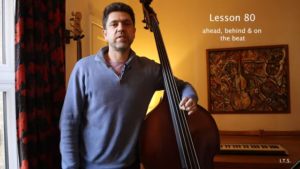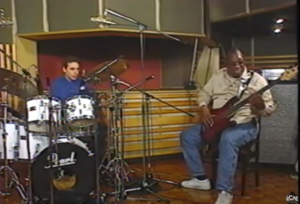CHAPTER 1: PROJECT OVERVIEW(プロジェクトの概要)
I have been a professional jazz accompanist for the last ten years. After completing my Master of Music in Jazz Studies from the Jacobs School of Music at Indiana University, Bloomington in 2000, I moved to Chicago, Illinois to improve my jazz performance skills and teach at the university level. I soon realized that I had a distinct passion for accompanying jazz vocalists. Pursuing a Doctor of Musical Arts at the University of Illinois at Urbana-Champaign gave me a research opportunity to further investigate my passion for vocal jazz accompanying. This study examines the techniques, methods and art of accompanying the jazz vocalist. It specifically investigates how the piano accompanist interacts with and supports the jazz vocalist in duo and small ensemble situations.
私は過去10年間、プロのジャズ伴奏者として活動しています。2000年にインディアナ大学ブルーミントン校のジェイコブ音楽学部でジャズ研究の修士号を取得し、ジャズの演奏技術を向上させるためにイリノイ州シカゴに移り、大学レベルで教えることになりました。すぐに、ジャズボーカリストの伴奏に対する独特の情熱を抱いていることに気づきました。イリノイ大学アーバナ・シャンペーン校で芸術博士号を追求することにより、ジャズボーカル伴奏に対する情熱を更に追求する研究の機会を得ました。この研究は、ジャズボーカリストの伴奏技術、方法、芸術を調査します。具体的には、ピアノ伴奏者がデュオや小編成の状況でジャズボーカリストとどのように相互作用し、サポートするかを調べます。
Though the jazz pianist assumes many roles in an often multi-faceted career, the responsibility of vocal accompaniment is frequently neglected, taken for granted and sometimes even disparaged. Accompanying is a delicate and demanding art. Developing a close rapport with a vocalist takes time. A successful working relationship between the pianist and vocalist is ultimately an act of symbiosis; the best practitioners possess a special ability to work effortlessly in sync. Accompanying improves gradually through trial and error experience on the bandstand and with deep reflective study.
ジャズピアニストは、しばしば多角的なキャリアで多くの役割を担いますが、ボーカル伴奏の責任はしばしば省かれ、当たり前のことと見なされ、時には軽視されることがあります。伴奏は繊細で要求される芸術です。ボーカリストとの緊密な関係を築くには時間がかかります。ピアニストとボーカリストの成功した協働関係は、最終的には共生の行為であり、最高の実践者はスムーズに同調して働く特別な能力を持っています。伴奏は、ステージでの試行錯誤の経験と深い反省的な研究を通じて徐々に向上します。
To my knowledge, this subject has not been written about or researched extensively, nor has there been a dissertation or thesis directly devoted to the topic. . This project assembles the disparate pieces of information currently in print about the subject, and draws insights from established artists through personal interviews. As a vocal accompanist continually striving to improve my own skills, obtaining opinions from extraordinary accompanists added enormously to my understanding of my own musical role with vocalists. Ultimately, I feel the project will be of lasting value to jazz performers and educators alike, and it is my hope that others will continue to write and study the art of jazz vocal accompaniment.
私の知る限り、このテーマについては十分に書かれたり研究されたりしておらず、直接的にこのテーマに特化した博士論文や学位論文もありません。本プロジェクトでは、現在出版されている分散された情報をまとめ、個人インタビューを通じて確立されたアーティストからの洞察を得ています
Much has been written about Billie Holiday, Sarah Vaughan and Ella Fitzgerald and other outstanding vocalists throughout jazz history. Yet, disproportionately, only a few vocal accompanists are mentioned, such as pianists Tommy Flanagan, George Shearing and Hank Jones. Several current artists may not have the name recognition of these giants, but passionately devote an enormous amount of time and energy to the art of vocal accompaniment. These artists have much to share about their craft. However, until now, their thoughts and ideas have not been documented extensively in print, if at all.
ビリー・ホリデイ、サラ・ヴォーン、エラ・フィッツジェラルドなど、ジャズ史上の優れたボーカリストについて多くの書物が存在します。しかし、ピアニストのトミー・フラナガン、ジョージ・シアリング、ハンク・ジョーンズなど、ごくわずかな伴奏者しか言及されていません。現在のアーティストの中には、これらの巨匠たちと同じような名前の知名度はありませんが、ボーカルの伴奏芸術に多大な時間とエネルギーを注いでいます。これらのアーティストたちは、自分たちの技術について多くを語ることができますが、その思考やアイデアは、これまで印刷物で広く文献化されたものはありませんでした。
This project investigates how the accompanist learns the art of vocal accompanying through initial musical influences, including listening to recordings, attending live concerts and through hands-on experience. It also examines how accompanists develop their collaborative skills through the attention to lyrics and careful choice of chord voicings. This study also explores the differences between accompanying instrumentalists and vocalists, and points out the commonalities and differences of opinion among the interviewed candidates. My long-term goal is to expand this project into a method book or a more comprehensive study, which incorporates comments, ideas and transcriptions from other established artists.
このプロジェクトでは、録音を聴くこと、ライブコンサートに参加すること、そして実際の演奏経験を通じて、伴奏者がボーカルの伴奏芸術をどのように学ぶかを調査しています。また、歌詞への注意や和音選択によって、伴奏者が協力的なスキルをどのように発展させるかを検討しています。さらに、楽器演奏者とボーカリストの伴奏の違いを探り、インタビューされた候補者の共通点と意見の相違点を指摘しています。長期的な目標は、他の確立されたアーティストのコメント、アイデア、トランスクリプションを組み込んだ、より包括的な研究や方法書に拡大することです。
Several articles in trade magazines have been written about vocal accompaniment (see references and recordings). Jazz artists who feel strongly about this neglected skill wrote the most enlightening and instructive articles. Laurence Hobgood and Bill Charlap are two accompanists who share similar viewpoints in print regarding the necessity of improving vocal accompaniment skills.1 Aside from a few articles there are no scholarly books devoted to the topic. The accompaniment of instrumental jazz performance is given much more attention. Paul Berliner’s Thinking in Jazz delves deeply into the subtleties and nuances inherent in instrumental jazz performances, focusing on the infinite art of improvisation, with additional insights on group interaction and arranging practices.2 Though it is thoroughly researched and contains many perceptive observations, Thinking in Jazz has little to say about the interaction between the jazz vocalist and the accompanist. Nevertheless, Berliner’s book was an excellent model for this project and his method of creating a work based primarily on interviews supplemented by transcriptions inspired the format and direction for my paper.
多くの取引雑誌にはヴォーカルアコンパニメントに関する記事がいくつか書かれており(参考文献および録音を参照)、この見過ごされたスキルに強く思い入れるジャズアーティストたちが最も啓発的で指導的な記事を書いています。ローレンス・ホブグッドとビル・シャーラップは、ヴォーカルアコンパニメントのスキルを向上させる必要性について、印刷物で同様の見解を共有している2人のアコンパニストです。1 いくつかの記事を除いて、このトピックに特化した学術的な書籍はありません。インストゥルメンタルジャズ演奏の伴奏には、より多くの注意が払われています。ポール・バーリナーの『Thinking in Jazz』は、インストゥルメンタルジャズ演奏に固有の微妙なニュアンスに深く踏み込んで、無限の即興芸術に焦点を当て、グループの相互作用やアレンジの実践についての洞察を提供しています。しかし、それは徹底的に研究され、多くの洞察力のある観察を含んでいますが、ジャズボーカリストとアコンパニストの相互作用についてはあまり言及していません。それでも、バーリナーの本はこのプロジェクトにとって優れたモデルであり、インタビューに基づいて主に作品を作成し、転写で補完する方法が、私の論文のフォーマットと方向性を着想したものです。
I interviewed eight pianists via e-mail or Skype for this project, occasionally supplementing their ideas with musical transcriptions to further illuminate their points. I feel that these pianists are among the best accompanists in jazz and I was grateful that they were willing to share their ideas and insights about jazz accompanying. These highly accomplished musicians spoke articulately about their art. Their playing styles are unique but it is fascinating to see the issues upon which they agree and differ.
このプロジェクトでは、8人のピアニストを電子メールまたはSkypeでインタビューし、彼らのアイデアを必要に応じて楽曲の転写で補足し、ヴォーカルアコンパニメントの芸術についての彼らのアイデアと洞察を共有してくれたことに感謝しています。これらの高度な演奏家たちは、彼らの芸術について明瞭に話しました。彼らの演奏スタイルはユニークですが、彼らが同意し、異なる問題を見るのは魅力的です。
As was Berliner’s goal, the artists’ viewpoint was the intended focal point rather than a critic’s or this author’s, yet throughout the work I add my own professional insights. My bibliography includes several books that describe the classical approach to piano accompaniment because of the similarities in jazz and classical accompaniment; the two art forms are not mutually exclusive. Devices such as text painting and thought- provoking preludes and postludes in the lieder of Schubert and Schumann, for example, occur in jazz, though perhaps not often enough. The ideas of noted classical accompanist Gerald Moore remain remarkably relevant to the jazz musician and I quote him liberally. As an aid to aspiring accompanists, this project also includes a chapter of practical advice. Lastly, a chapter presents the vocalist’s perspective of the accompanist; the picture would not be complete without some opinion from the other half of the duo.
本書の目的は、ベルリナーの目標と同様に、芸術家の視点を扱うことです。批評家や筆者自身の視点ではなく、ただし、専門家の知見を加えています。私の参考文献には、ジャズとクラシックの伴奏には共通点があるため、クラシック音楽におけるピアノの伴奏方法について説明した書籍も含まれています。例えば、シューベルトやシューマンのリーダーにおけるテキスト・ペインティングや考えさせるような前奏曲や後奏曲などのデバイスは、ジャズでも起こりうることですが、おそらくそれほど頻繁ではありません。有名なクラシック伴奏者であるジェラルド・ムーアのアイデアは、現在でもジャズミュージシャンにとって非常に関連性があり、彼の引用をたっぷりと取り入れています。伴奏者を目指す人々の支援のために、このプロジェクトには実践的なアドバイスの章も含まれています。最後に、一つの章ではボーカリストの視点から伴奏者を見たものも取り上げられています。デュオのもう一方の意見がなければ、全体像は完全ではありません。

